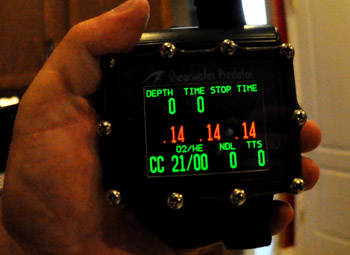|
|
|
By Curt Bowen |
|
|
|
On any rebreather, oxygen is the main gas that keeps the diver alive. Eliminate the supply of oxygen for a short period of time is all that is needed to end in tragedy.
For many years, divers have been utilizing a simple device commonly called a “leaky valve”. This device allows a set volume of oxygen to flow freely into the rebreather and is unaffected by increased depth. The amount delivered is controlled by the first stage regulator’s intermediate pressure (IP) and a specific orifice size.
Lower the IP and the volume of oxygen are diminished, increase the IP and the volume is increased. The ideal volume delivered to a diver is adjusted to match their metabolic oxygen consumption at a low workload.
The following test was conducted to help illustrate the importance of a constant flow oxygen orifice.
|
|
|
Test A |
No Constant Flow Orifice |
|
Test Parameters |
|
|
• |
Oxygen start set point above 0.7 PPO2 |
• |
Normoxic Diluent (21% oxygen / 79% nitrogen) used to maintain minimum loop volume during test. (ADV manually added gas as counter lungs pulled a negative pressure) |
| • |
Minimum loop volume maintained = (volume required to take a deep breath and bottom out the counter lungs without the ADV adding diluent gas.) |
| • |
No Oxygen addition during test |
| • |
Test diver walked in place at a steady pace for duration of the test |
| • |
Divers nose was blocked to prevent gas leaking or addition |
|
|
|
|
|
|
Test B |
Constant Oxygen Flow Orifice 0.8 lpm |
|
Test Parameters |
|
|
• |
Oxygen start set point above 0.7 PPO2 |
• |
Normoxic Diluent (21% oxygen / 79% nitrogen) used to maintain minimum loop volume during test. (ADV manually added gas as counter lungs pulled a negative pressure) |
| • |
Minimum loop volume maintained = (volume required to take a deep breath and bottom out the counter lungs without the ADV adding diluent gas.) |
| • |
Oxygen addition during test at 0.8 lpm through orifice |
| • |
No additional oxygen added manually |
| • |
Test diver walked in place at a steady pace for duration of the test |
| • |
Divers nose was blocked to prevent gas leaking or addition |
|
|
|
|
|
|
|
| Time (minutes) |
Shearwater Triple PPO2 Display |
|
|
|
|
|
|
|
|
|
DEAD |
|
|
 |
|
|
|
|
| Time (minutes) |
Shearwater Triple PPO2 Display |
|
|
|
|
|
|
|
|
|
|
|
|
|
|
|
|
|
|
|
|
|
|
|
|
STILL ALIVE |
|
|
|
|
|
|
|
The above simple test clearly indicates the importance of a continuous flow orifice on any rebreather. Increased workloads or added diver stress will greatly affect the results of oxygen consumption, reducing both test A and B significantly.
Adding a continuous flow device on a solenoid electronically controlled closed circuit rebreather can reduce the workload of the solenoid and add a significant safety net for electronics failure.
|
|
|
|